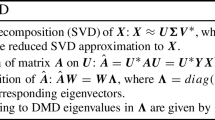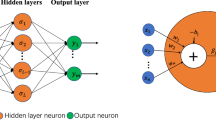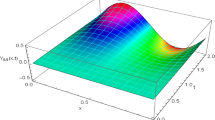Abstract
In this paper, a reduced-order model (ROM) based on the proper orthogonal decomposition and the discrete empirical interpolation method is proposed for efficiently simulating time-fractional partial differential equations (TFPDEs). Both linear and nonlinear equations are considered. We demonstrate the effectiveness of the ROM by several numerical examples, in which the ROM achieves the same accuracy of the full-order model (FOM) over a long-term simulation while greatly reducing the computational cost. The proposed ROM is then regarded as a surrogate of FOM and is applied to an inverse problem for identifying the order of the time-fractional derivative of the TFPDE model. Based on the Levenberg–Marquardt regularization iterative method with the Armijo rule, we develop a ROM-based algorithm for solving the inverse problem. For cases in which the observation data is either uncontaminated or contaminated by random noise, the proposed approach is able to achieve accurate parameter estimation efficiently.
















Similar content being viewed by others
References
Armijo, L.: Minimization of functions having Lipschitz continuous partial derivatives. Pac. J. Math. 16, 1–3 (1966)
Antoulas, A.C.: Approximation of Large-Scale Dynamical Systems, vol. 6. Society for Industrial and Applied Mathematics, Philadelphia, PA (2005)
Benson, D., Wheatcraft, S.W., Meerschaert, M.M.: The fractional-order governing equation of Lévy motion. Water Resour. Res. 36(6), 1413–1423 (2000)
Bui-Thanh, T., Willcox, K., Ghattas, O., van Bloemen Waanders, B.: Goal-oriented, model-constrained optimization for reduction of large-scale systems. J. Comput. Phys. 224(2), 880–896 (2007)
Burkardt, J.V., Gunzburger, M., Lee, H.C.: POD and CVT-based reduced-order modeling of Navier-Stokes flows. Comput. Methods Appl. Mech. Eng. 196(1–3), 337–355 (2006)
Carlberg, K., Farhat, C.: A low-cost, goal-oriented ’compact proper orthogonal decomposition’ basis for model reduction of static systems. Int. J. Numer. Meth. Eng. 86(3), 381–402 (2011)
Chaturantabut, S., Sorensen, D.C.: Application of POD and DEIM on dimension reduction of non-linear miscible viscous fingering in porous media. Math. Comput. Model. Dyn. 17(4), 337–353 (2011)
Chaturantabut, S., Sorensen, D.C.: A state space error estimate for POD-DEIM nonlinear model reduction. SIAM J. Numer. Anal. 50, 46–63 (2012)
Chaturantabut, S., Sorensen, D.C., Steven, J.C.: Nonlinear model reduction via discrete empirical interpolation. SIAM J. Sci. Comput. 32(5), 2737–2764 (2010)
Chavent, G.: Nonlinear Least Squares for Inverse Problems: Theoretical Foundations and Step-by-Step Guide for Applications. Springer, Netherlands (2009)
Chen, S., Liu, F., Jiang, X., Turner, I., Burrage, K.: Fast finite difference approximation for identifying parameters in a two-dimensional space-fractional nonlocal model with variable diffusivity coefficients. SIAM J. Numer. Anal. 54(2), 606–624 (2016)
Cheng, J., Nakagawa, J., Yamamoto, M., Yamazaki, T.: Uniqueness in an inverse problem for a one-dimensional fractional diffusion equation. Inverse Probl. 25(11), 115002 (2009)
Daescu, D.N., Navon, I.M.: A dual-weighted approach to order reduction in 4DVAR data assimilation. Mon. Weather Rev. 136(3), 1026–1041 (2008)
del-Castillo-Negrete, D., Carreras, B.A., Lynch, V.E.: Fractional diffusion in plasma turbulence. Phys. Plasmas 11(8), 3854 (2004)
Gal, N., Weihs, D.: Experimental evidence of strong anomalous diffusion in living cells. Phys. Rev. E 81(2), 020903 (2010)
Glöckle, W.G., Nonnenmacher, T.F.: A fractional calculus approach to self-similar protein dynamics. Biophys. J. 68(1), 46–53 (1995)
Holmes, P., Lumley, J.L., Berkooz, G.: Turbulence, Coherent Structures. Dynamical Systems and Symmetry. Cambridge University Press, Cambridge (1996)
Iollo, A., Lanteri, S., Désidéri, J.A.: Stability properties of POD-Galerkin approximations for the compressible Navier-Stokes equations. Theor. Comput. Fluid Dyn. 13(6), 377–396 (2000)
Jin, B., Rundell, W.: An inverse problem for a one-dimensional time-fractional diffusion problem. Inverse Probl. 28(7), 075010 (2012)
Ke, R., Ng, M.K., Sun, H.: A fast direct method for block triangular Toeplitz-like with tri-diagonal block systems from time-fractional partial differential equations. J. Comput. Phys. 303, 203–211 (2015)
Kunisch, K., Volkwein, S.: Galerkin proper orthogonal decomposition methods for parabolic problems. Numer. Math. 90(1), 117–148 (2001)
Lu, X., Pang, H., Sun, H.: Fast approximate inversion of block triangular Toeplitz matrices with application to sub-diffusion equations. Numer. Linear Algebra Appl. 22(5), 866–882 (2015)
Lin, Y., Xu, C.: Finite difference/spectral approximations for the time-fractional diffusion equation. J. Comput. Phys. 225, 1533–1552 (2007)
Maday, Y., Rønquist, E.M.: A reduced-basis element method. J. Sci. Comput. 17(1–4), 447–459 (2002)
Magin, R.L.: Fractional Calculus in Bioengineering. Begell House Publishers, Redding (2006)
Meerschaert, M.M., Sikorskii, A.: Stochastic Models for Fractional Calculus. De Gruyter Studies in Mathematics, vol. 43. Walter de Gruyter, Berlin (2012)
Metler, R., Klafter, J.: The random walk’s guide to anomalous diffusion: a fractional dynamics approach. Phys. Rep. 339(1), 1–77 (2000)
Metler, R., Klafter, J.: The restaurant at the end of random walk: recent developments in the description of anomalous transport by fractional dynamics. J. Phys. A: Math. Gen. 37(31), R161–R208 (2004)
Nocedal, J., Wright, S.J.: Numerical Optimization. Springer, New York (2006)
Patera A.T., Rozza, G.: Reduced basis approximation and a posteriori error estimation for parametrized partial differential equations. Version 1.0, Copyright MIT 2006, to appear in (tentative rubric) MIT Pappalardo Graduate Monographs in Mechanical Engineering
Podlubny, I.: Fractional Differential Equations. Academic Press, New York (1999)
Raberto, M., Scalas, E., Mainardi, F.: Waiting-times and returns in high-frequency financial data: An empirical study. Phys. A: Stat. Mech. Appl. 314(1–4), 749–755 (2002)
Stefănescu, R., Navon, I.M.: POD/DEIM nonlinear model order reduction of an ADI implicit shallow water equations model. J. Comput. Phys. 237, 95–114 (2013)
Sirisup, S., Karniadakis, G.E.: A spectral viscosity method for correcting the long-term behavior of POD models. J. Comput. Phys. 194(1), 92–116 (2004)
Sun, W., Yuan, Y.: Optimization Theory and Methods: Nonlinear Programming. Springer, New York (2006)
Lassila, T., Manzoni, A., Quarteroni, A., Rozza, G.: Model order reduction in fluid dynamics: challenges and perspectives. In: Reduced Order Methods for Modeling and Computational Reduction, pp. 235–273. Springer, Switzerland (2014)
Wang, J., Wei, T., Zhou, Y.: Tikhonov regularization method for a backward problem for the time-fractional diffusion equation. Appl. Math. Model. 37(18–19), 8518–8532 (2013)
Wei, H., Chen, W., Sun, H., Li, X.: A coupled method for inverse source problem of spatial fractional anomalous diffusion equations. Inverse Probl. Sci. Eng. 18(7), 945–956 (2010)
Xu, Q., Hesthaven, J.S., Chen, F.: A parareal method for time-fractional differential equations. J. Comput. Phys. 293, 173–183 (2015)
Zhuang, Q., Yu, B., Jiang, X.: An inverse problem of parameter estimation for time fractional heat conduction in a composite medium using carbon-carbon experimental data. Phys. B: Condens. Matter. 456, 9–15 (2015)
Wang, Z.: Nonlinear model reduction based on the finite element method with interpolated coefficients: semilinear parabolic equations. Numer. Methods Partial. Differ. Eqs. 31(6), 1713–1741 (2015)
Zeng, F., Zhang, Z., Karniadakis, G.E.: Fast difference schemes for solving high-dimensional time-fractional subdiffusion equation. J. Comput. Phys. 307, 15–33 (2016)
Acknowledgements
The first author would like to thank the support of China Scholarship Council for visiting the Interdisciplinary Mathematics Institute at University of South Carolina during the year 2015–2016.
Author information
Authors and Affiliations
Corresponding author
Additional information
The authors are grateful for the supports from the National Natural Science Foundation of China through Grants 11201485, 11471194, 11571115 and 91630207, the Fundamental Research Funds for the Central Universities through Grants 14CX02217A and 16CX02050A, the National Science Foundation through Grants DMS-1522672, DMS-1216923 and DMS-1620194, the OSD/ARO MURI Grant W911NF-15-1-0562, and the office of the Vice President for Research at University of South Carolina from the ASPIRE-I program.
Rights and permissions
About this article
Cite this article
Fu, H., Wang, H. & Wang, Z. POD/DEIM Reduced-Order Modeling of Time-Fractional Partial Differential Equations with Applications in Parameter Identification. J Sci Comput 74, 220–243 (2018). https://doi.org/10.1007/s10915-017-0433-8
Received:
Revised:
Accepted:
Published:
Issue Date:
DOI: https://doi.org/10.1007/s10915-017-0433-8
Keywords
- Time-fractional partial differential equations
- Proper orthogonal decomposition
- Discrete empirical interpolation method
- Reduced-order model
- Parameter identification




